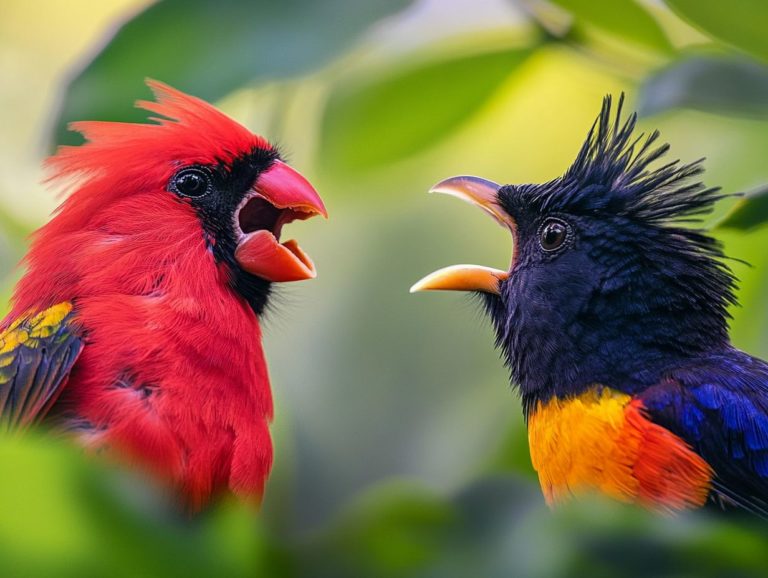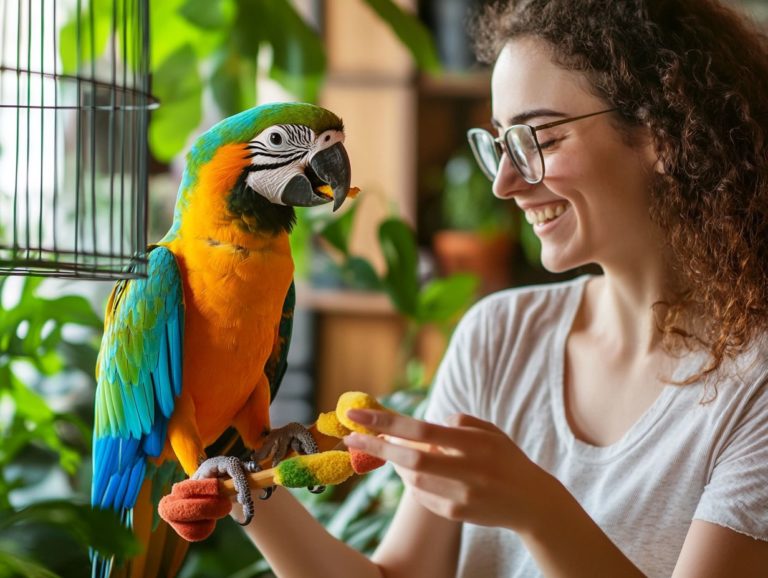How to Encourage Natural Foraging Behavior
Understanding natural foraging behavior is crucial for enhancing your pet’s well-being and nurturing their instincts.
This article delves into the concept of natural foraging and its numerous benefits. Think physical and mental stimulation, along with a significant reduction in boredom and behavioral issues.
You will find practical guidance on creating a foraging-friendly environment and selecting the right toys.
You’ll also learn how to set up engaging stations that captivate your pet s interest.
You will also discover effective training techniques and key pitfalls to avoid.
Jump in and transform your pet’s life with the fun and rewarding experience of foraging!
Contents
- Key Takeaways:
- Understanding Natural Foraging Behavior
- Benefits of Encouraging Natural Foraging
- Creating a Foraging-Friendly Environment
- Teaching and Encouraging Foraging Behaviors
- Common Mistakes to Avoid
- Frequently Asked Questions
- What is natural foraging behavior?
- Why is it important to encourage natural foraging behavior in animals?
- How can I encourage natural foraging behavior in my pet?
- What types of animals benefit from natural foraging behavior?
- Are there any risks to encouraging natural foraging behavior?
- Can natural foraging behavior help with behavioral issues in animals?
Key Takeaways:

- Incorporating natural foraging into your pet’s routine provides physical and mental stimulation, preventing boredom and potential behavioral issues.
- Create a foraging-friendly environment by choosing the right toys and tools and setting up foraging stations to encourage your pet’s natural instincts.
- Avoid common mistakes such as overfeeding and making the foraging process too complicated to ensure your pet receives the full benefits of this natural behavior.
Understanding Natural Foraging Behavior
Understanding natural foraging behavior is essential for enhancing the well-being of captive animals, like rabbits, guinea pigs, and chinchillas, that reside in environments designed to reflect their natural habitats.
Foraging behavior encompasses the instincts and activities these animals undertake to locate food. These instincts are deeply rooted in their species-specific requirements.
Engaging in these behaviors satisfies their dietary needs and supports their mental health and overall performance an aspect that institutions such as the Detroit Zoo emphasize significantly.
What is Natural Foraging?
Natural foraging is the instinctive dance you see in animals as they seek out food in their natural environments. It often involves elaborate strategies, like food manipulation and exploration, showcasing their adaptability.
Each species has its own unique approach, finely tuned to its habitat and dietary needs.
For example, some birds rely on spatial memory to find hidden food caches. Larger mammals might use social structures to enhance group foraging efforts.
These behaviors are intricately connected to their nutritional needs. Animals adapt their foraging strategies to seasonal changes and food availability, ensuring they meet their energy demands and maintain a balanced diet.
Environmental factors, such as habitat types and interspecies competition, play pivotal roles in shaping these techniques. This underscores the intricate relationship between animals and their ecosystems.
Benefits of Encouraging Natural Foraging
Encouraging natural foraging behaviors in captive environments offers a wealth of benefits that elevate both the physical and mental well-being of animals. This ultimately enhances their welfare and overall quality of life.
Promoting foraging allows animals to engage their innate instincts.
This fosters both physical activity and mental stimulation.
Physical and Mental Stimulation
Engaging in foraging activities provides a vital source of physical activity that significantly boosts the overall health of captive animals.
It also enhances their mental well-being through enriched environmental stimulation.
By incorporating these natural behaviors into specific environmental enrichment strategies, you encourage animals to explore their surroundings. This simulates the processes they would naturally undertake in the wild.
This active exploration often leads to improved food intake, as animals become more skilled at locating diverse food sources.
Such stimulation fosters cognitive development and builds emotional resilience, helping to alleviate the stress and anxiety that can come with confinement.
By promoting a more dynamic daily routine, you facilitate the expression of innate behaviors, ultimately leading to enhanced overall well-being and performance in these remarkable creatures.
Preventing Boredom and Behavioral Issues

Preventing boredom in captive settings is crucial. It can lead to significant behavioral issues among animals. An effective activity plan is essential for fostering positive behaviors.
When animals lack mental stimulation and opportunities to engage in natural activities, they may show signs of stress, aggression, or even depression. Behavioral problems affect animal well-being and make caretaking more challenging.
To counter these negative effects, a well-structured activity plan that includes both physical and cognitive activities can promote exploration, social interaction, and play. By incorporating a variety of engaging materials, sensory experiences, and problem-solving opportunities, you can create a more dynamic habitat that supports mental health and enhances overall animal welfare.
Creating a Foraging-Friendly Environment
A foraging-friendly environment is a game changer for animals! It enables them to engage in natural behaviors that enhance their well-being while meeting their nutritional needs.
Get creative with habitat accessories and foraging stations! You ll boost food accessibility and spark exploration. This can include climbing structures and sensory elements that enrich their daily experiences.
Choosing the Right Toys and Tools
Selecting the right toys and tools to encourage foraging behavior is crucial. They significantly enhance food manipulation and sensory engagement for captive animals.
These specially crafted items don t just stimulate natural instincts; they also promote physical activity, contributing to the overall health and well-being of the animals. For instance, puzzle feeders challenge them to earn their meals, mimicking the effort they would expend in the wild. Hiding treats in foraging mats encourages exploration and sharpens their problem-solving skills.
Enrichment toys, such as hanging food baskets, can also be incredibly beneficial. They require animals to reach, climb, and manipulate, which boosts their strength and coordination. Ultimately, incorporating a variety of these foraging tools will create a more dynamic and enriching environment, resulting in happier, healthier animals.
Setting Up Foraging Stations
Setting up foraging stations offers a sophisticated way to enrich the environment for animals. It promotes their natural foraging behaviors by enhancing food accessibility and encouraging exploration.
By thoughtfully designing these stations, you can replicate wild conditions that inspire animals to engage in their instinctual activities. Each station can feature diverse layouts, such as scattered food items to provoke searching behaviors or enclosed spaces that stimulate problem-solving skills.
Incorporating a variety of food types like fruits, vegetables, seeds, and protein sources ensures that the foraging stations meet the dietary needs of different species. By adjusting the complexity of these stations, you can tailor the challenges to suit various animals, enhancing their overall well-being and fostering more dynamic interactions within their environment.
Teaching and Encouraging Foraging Behaviors
You can teach and encourage foraging behaviors in captive animals using a variety of training techniques that reinforce positive actions.
By providing interactive opportunities, you’ll enable these animals to engage more fully with their environment, nurturing their instincts and enhancing their well-being.
Training Techniques and Tips

Implementing effective training techniques is essential for encouraging foraging behaviors. Employing positive reinforcement, which means rewarding animals for good behavior to encourage them to repeat it, can greatly enhance both animal behavior and overall well-being.
By incorporating engaging activities specially designed for the species in your care, you can create stimulating environments that closely mimic their natural conditions. For example, consider placing food in hidden spots or using puzzle feeders. This encourages animals to search and work for their meals, promoting mental engagement.
As a caregiver, be sure to watch closely and observe each animal’s unique preferences and habits. Tailoring the training to their specific needs is crucial. Rewarding positive behaviors with treats or verbal praise not only strengthens the bond between you and the animal but also reinforces the desired foraging actions.
This thoughtful approach to activities that improve animal behavior nurtures natural instincts while significantly contributing to the mental and physical health of the animals.
Reinforcing Positive Behaviors
Reinforcing positive behaviors is essential for creating an environment where animals can truly thrive. This approach aligns with their behavioral needs and significantly enhances their overall welfare, including animal welfare.
By employing strategies such as clicker training and reward systems, you can help animals associate desirable actions with positive outcomes. These methods enrich their learning experiences and build trust, strengthening the bond between animals and humans.
Integrating reinforcement techniques into a comprehensive enrichment program ensures that every animal receives the tailored support necessary to flourish in its unique environment. This approach shapes behavior patterns that encourage both mental stimulation and physical activity.
Common Mistakes to Avoid
Understanding common mistakes is crucial for fostering effective foraging behaviors. Pitfalls like overfeeding and poor food selection can create nutritional imbalances that negatively impact animal welfare.
By being aware of these issues, you can ensure a healthier, more balanced environment for your animals.
Overfeeding and Food Selection
Overfeeding and poor food selection can jeopardize dietary needs and lead to nutritional imbalances, ultimately impacting the welfare of captive animals.
When animals are given excessive calories without the essential nutrients they truly require, they’re at risk of obesity, diabetes, and other chronic health conditions. These dietary missteps affect their physical health and influence behavior, making animals more lethargic and less engaged in their natural activities.
As a caretaker or pet owner, prioritize a balanced diet that includes the right proportions of proteins, vitamins, and minerals specifically tailored to each species’ needs. By understanding the consequences of overfeeding and opting for high-quality food options, you can significantly enhance both physical health and behavioral well-being.
This approach fosters a more enriched and compassionate environment for these animals, ensuring they thrive under your care.
Overcomplicating the Foraging Process
Overcomplicating the foraging process leads to frustration for animals. This detracts from their positive experiences and undermines the enriching environment you want to create.
When animals encounter overly complex foraging tasks, their natural instincts can be stifled. This can result in behaviors that signal stress or disinterest.
These complexities can stop them from participating in a fun activity, ultimately impacting their overall well-being.
It’s crucial to find the right balance for exciting and meaningful foraging! Introduce a variety of manageable challenges, such as using familiar scents or straightforward hiding spots. By understanding each species’ unique preferences and designing foraging setups accordingly, you can promote both physical and mental engagement. This fosters a healthier, happier environment that enhances the animals’ quality of life.
Frequently Asked Questions

What is natural foraging behavior?
Natural foraging behavior refers to the instinctive behavior of animals to search for and acquire food in their natural habitat.
Why is it important to encourage natural foraging behavior in animals?
Encouraging natural foraging behavior provides mental and physical stimulation, promotes natural instincts, and can improve their overall well-being and health.
How can I encourage natural foraging behavior in my pet?
There are various ways to encourage natural foraging behavior, such as hiding food in different locations, using food-dispensing toys, and providing opportunities for the animal to search for and obtain food on their own.
What types of animals benefit from natural foraging behavior?
All types of animals can benefit from natural foraging behavior, including dogs, cats, birds, as well as small animals like rabbits and hamsters.
Are there any risks to encouraging natural foraging behavior?
In most cases, there are no risks to encouraging natural foraging behavior. However, it is important to supervise and monitor the animal’s behavior to ensure they are not consuming anything harmful.
Can natural foraging behavior help with behavioral issues in animals?
Yes, encouraging natural foraging behavior can help alleviate behavioral issues in animals, such as boredom, anxiety, and destructive behavior, by providing mental and physical stimulation.






